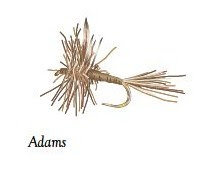Flies
The object of fly-fishing is to fool the fish into thinking the fly is its natural prey. Flies imitate the foods fish eat in size, color, and shape. Flies can be made or bought in different sizes and patterns. The ones you choose will depend on what fish are feeding. Choose medium hook sizes (8-16) to start.
Surface Flies
Surface flies float. The fascinating thing about fishing with a fly on the water surface is that you can see when a fish comes up and bites it. Dry flies, terrestrials, and bugs are all surface flies.

Dry Flies
Dry flies imitate adult aquatic insects, especially mayflies, caddisflies, stoneflies, midges, and terrestrials. They are used mostly for trout, but other fish such as bass and panfish will strike a dry fly too. Some common flies are Hendrickson’s, pale evening duns, Adams, and elk hair caddis.

Terrestrials
Terrestrial flies imitate ants, beetles, spiders, caterpillars, crickets, grasshoppers, and other insects that live on the land and sometimes fall into the water. Twitch these flies to make them look like struggling insects. Look in the grass for the most common insects before choosing these flies.

Bugs
Bugs include poppers, divers, and sliders. Twitch these flies forward little by little to disturb the water and attract fish. They imitate large insects, frogs, or mice. Dahlberg divers and frog imitations are good for bass and northern pike. Smaller rubber legged poppers work well for panfish.
Sinking Flies
Sinking flies are made with heavy or absorbent materials so that they sink. Sinking flies include nymphs, wet flies, and streamers.
Nymphs
Nymphs imitate immature insects that live underwater. Nymphs are a big part of many fishes diets, including trout, bass, and panfish. Nymphs often catch fish when nothing else does. Hare’s ear and pheasant tail nymphs are good in a basic fly box.

Wet Flies
These were probably the first kind of fly ever made. They are made of materials that become waterlogged quickly and sink, so they look like drowned insects and sometimes baitfish. Try a woolly worm in your fly box.

Streamers
Larger predator fish, such as pike, muskies, large trout, and bass, are attracted to streamers because they look like baitfish. Retrieve these flies with a jerking motion to make them mimic swimming fish. Muddler or Clouser minnows, woolly buggers, and Mickey Finns are good basic streamers.

Specialty Flies
These are flies made for special situations. A fish-egg fly works in spawning season to catch rainbow trout. Crayfish flies work in summer when smallmouth bass are gobbling crayfish.

What Can I Catch?
Fly-fishing is not just for trout. Fly-fishing can be used to catch a variety of fish but works best to catch fish that feed by sight.
Read More The Articel
Please free download link below :
Adapted From Minessota Fly Fishing Basic
* First Articel
* Second Articel







